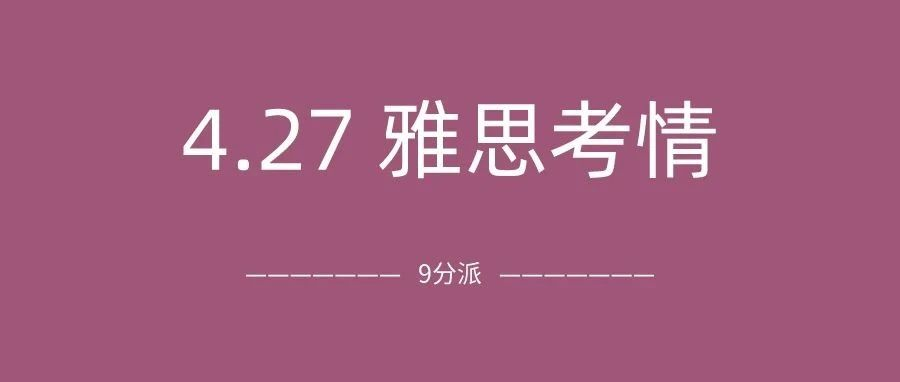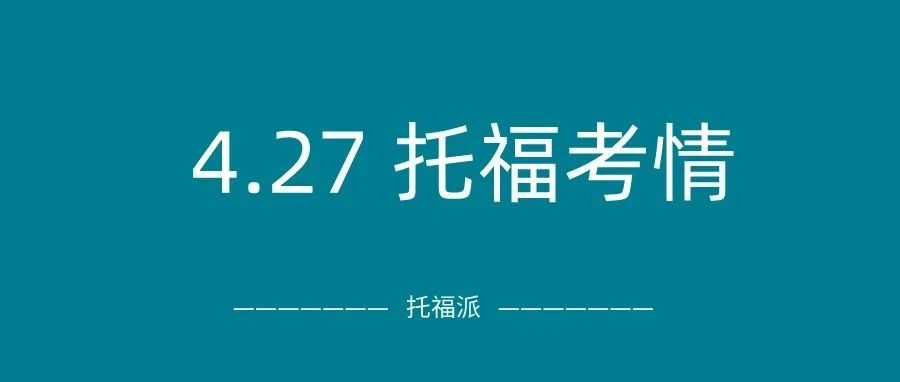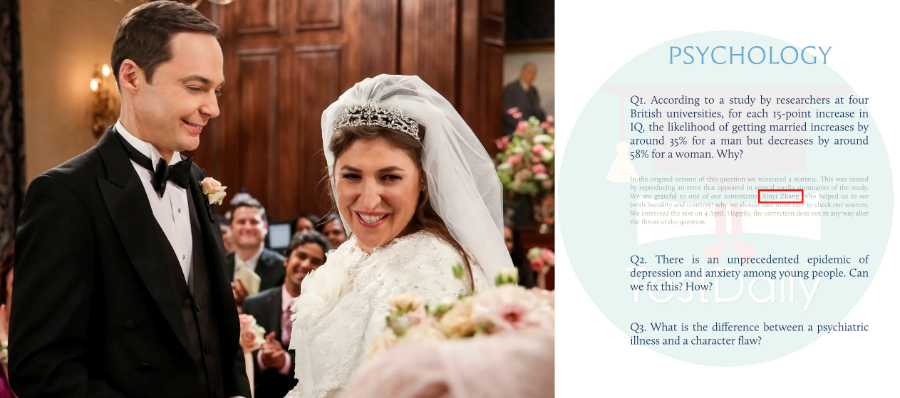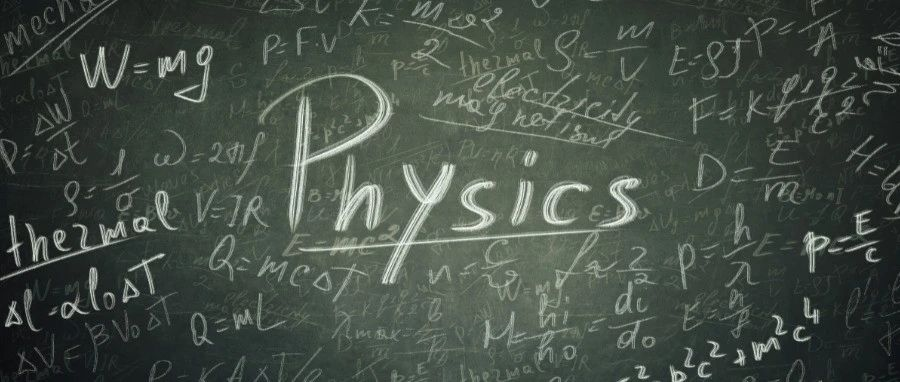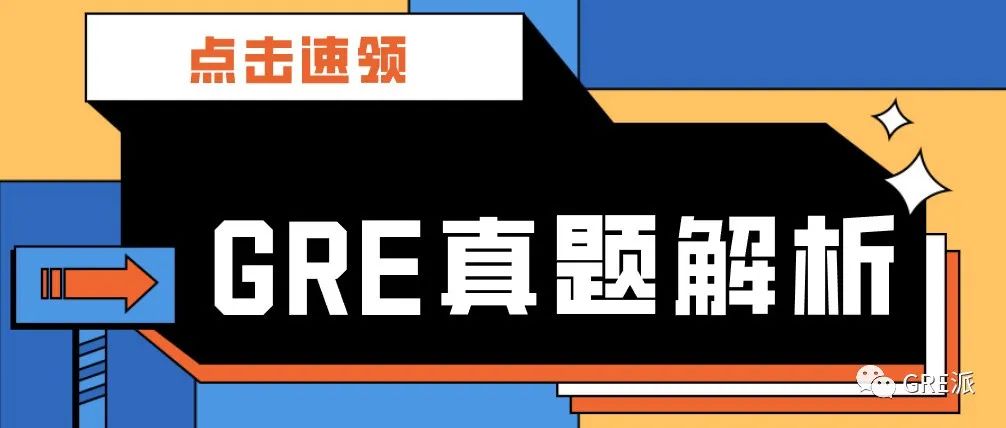
市面上流传的GRE阅读机经真题有三百多篇,同时又存在多种版本的答案和解析,有些疑难题目让考生不知道听谁的,还有些版本的解析像是用谷歌翻译把同题目和选项翻译了一下。TD GRE教研组认为,GRE阅读的解析,可以讲得再清楚一点。
GRE不光有技巧,不光有快速解题法,GRE更加考察大家的逻辑硬实力,文字理解实打实的深度。良好的GRE备考应当在课堂上向老师学习快速解题法,取同取反逻辑的同时,课下扎扎实实的读懂每一句话。读懂,是一切技巧使用的前提。皮之不存,毛将焉附?
有感于此,我们尝试用比较长的时间,原创一个解析,力求做到超详细,大白话,包你懂。之前为大家推送了Passage 1 – Passage 70的解析,今天继续为大家推出Passage 71(长阅读)解析,这篇阅读一共有3段,共7道题,TD版超详细「包你懂」系列对此篇文章进行了清楚地解析。
GRE阅读真题第71段
The Fourteenth Amendment to the United States Constitution, ratified in 1868, prohibits state governments from denying citizens the “equal protection of the laws.” Although precisely what the framers of the amendment meant by this equal protection clause remains unclear, all interpreters agree that the framers’ immediate objective was to provide a constitutional warrant for the Civil Rights Act of 1866, which guaranteed the citizenship of all persons born in the United States and subject to United States jurisdiction. This declaration, which was echoed in the text of the Fourteenth Amendment, was designed primarily to counter the Supreme Court’s ruling in Dred Scott v. Sandford that Black people in the United States could be denied citizenship. The act was vetoed by President Andrew Johnson, who argued that the Thirteenth Amendment, which abolished slavery, did not provide Congress with the authority to extend citizenship and equal protection to the freed slaves. Although Congress promptly overrode Johnson’s veto, supporters of the act sought to ensure its constitutional foundations with the passage of the Fourteenth Amendment.
The broad language of the amendment strongly suggests that its framers were proposing to write into the Constitution not a laundry list of specific civil rights but a principle of equal citizenship that forbids organized society from treating any individual as a member of an inferior class. Yet for the first eight decades of the amendment’s existence, the Supreme Court’s interpretation of the amendment betrayed this ideal of equality. In the Civil Rights Cases of 1883, for example, the Court invented the “state action” limitation, which asserts that “private” decisions by owners of public accommodations and other commercial business to segregate their facilities are insulated from the reach of the Fourteenth Amendment’s guarantee of equal protection under the law.
After the Second World War, a judicial climate more hospitable to equal protection claims culminated in the Supreme Court’s ruling in Brown v. Board of Education that racially segregated schools violated the equal protection clause of the Fourteenth Amendment. Two doctrines embraced by the Supreme Court during this period extended the amendment’s reach. First, the Court required especially strict scrutiny of legislation that employed a “suspect classification,” meaning discrimination against a group on grounds that could be construed as racial. This doctrine has broadened the application of the Fourteenth Amendment to other, nonracial forms of discrimination, for while some justices have refused to find any legislative classification other than race to be constitutionally disfavored, most have been receptive to arguments that at least some nonracial discriminations, sexual discrimination in particular, are “suspect” and deserve this heightened scrutiny by the courts. Second, the Court relaxed the state action limitation on the Fourteenth Amendment, bringing new forms of private conduct within the amendment’ s reach.
GRE阅读文章解析
第一段第一句 :
The Fourteenth Amendment to the United States Constitution, ratified in 1868, prohibits state governments from denying citizens the “equal protection of the laws.”
白话版讲解:
1868 年批准的美国宪法第十四条修正案禁止州政府不给予公民获得“平等法律保护”的权利。(第十四条修正案要求州政府不得拒绝给予任何人以平等法律保护 。)
(当时的美国社会还存在奴隶制,黑人没有公民权,得不到法律的保护。)
第二句 :
Although precisely what the framers of the amendment meant by this equal protection clause remains unclear, all interpreters agree that the framers’ immediate objective was to provide a constitutional warrant for the Civil Rights Act of 1866, which guaranteed the citizenship of all persons born in the United States and subject to United States jurisdiction.
白话版讲解:
尽管人们并不知道这条修正案的制定者们眼中的这条平等保护条款真正意味着什么,但所有对这条修正案进行解读的人都认为,制定者们当初最迫切的目标,是为 《1866 年民权法案》提供宪法层面的担保。《1866 年民权法案》确保了所有出生在美国的公民都会受到美国法律的管制。
第三句 :
This declaration, which was echoed in the text of the Fourteenth Amendment, was designed primarily to counter the Supreme Court’s ruling in Dred Scott v. Sandford that Black people in the United States could be denied citizenship.
白话版讲解:
这一宣言(也就是人人都有获得“平等法律保护”的权利)在第十四条修正案中重复了数次。一开始,这条宣言是为了驳斥美国最高法院对于斯科特诉桑福德案的审判结果。这一审判结果认为,在美国生活的黑人并不拥有公民权。
第四句 :
The act was vetoed by President Andrew Johnson, who argued that the Thirteenth Amendment, which abolished slavery, did not provide Congress with the authority to extend citizenship and equal protection to the freed slaves.
白话版讲解:
这条法案(即《1866 年民权法案》)受到安德鲁·约翰逊总统(President Andrew Johnson)的否决。他认为第十三条修正案里虽然禁止了奴隶制,但并没有赋予国会权力,让其能够给予自由的黑人公民权,以及平等的保护。
第五句 :
Although Congress promptly overrode Johnson’s veto, supporters of the act sought to ensure its constitutional foundations with the passage of the Fourteenth Amendment.
白话版讲解:
尽管国会很快推翻了约翰逊总统的否决,但支持这条法案的人希望它能够在宪法层面有据可循,因此通过了第十四条修正案。
第二段第一句 :
The broad language of the amendment strongly suggests that its framers were proposing to write into the Constitution not a laundry list of specific civil rights but a principle of equal citizenship that forbids organized society from treating any individual as a member of an inferior class.
白话版讲解:
第十四条修正案的用词抽象,概括性强,这说明这条修正案的制定者想要写进宪法的不是一条条具体的民事权利,而是人人都能获得平等公民权的基本原则。这条原则禁止社会把任一群体的任一成员当成是下等人来对待。
第二句 :
Yet for the first eight decades of the amendment’s existence, the Supreme Court’s interpretation of the amendment betrayed this ideal of equality.
白话版讲解:
但是,在这条修正案批准之后的前 80 年里,最高法院对它的解读却背叛了平等的原则。
第三句 :
In the Civil Rights Cases of 1883, for example, the Court invented the “state action” limitation, which asserts that “private” decisions by owners of public accommodations and other commercial business to segregate their facilities are insulated from the reach of the Fourteenth Amendment’s guarantee of equal protection under the law.
白话版讲解:
例如,美国最高法院在 1883 年处理的几件民权案件中,法院提出了“政府行为限制”的说法,认为公共场所和企业做出的的“私人”种族隔离行为并不受到第十四条修正案的管制。
(法院的判决推理是,第十四条修正案只禁止州政府实施种族歧视,而不适用于私人公民或企业。第十四修正案没有授权国会制定法律来处理私人公民或企业的种族歧视。)
第三段第一句 :
A fter the Second World War, a judicial climate more hospitable to equal protection claims culminated i n the Supreme Court’s ruling in Brown v. Board of Education that racially segregated schools violated the equal protection clause of the Fourteenth Amendment.
白话版讲解:
在第二次世界大战之后,一种更有利于“人人有权获得平等保护”的司法思潮在最高法院对布朗诉托皮卡教育局案的判决中达到了顶峰,该判决认为实行种族隔离的学校违反了第十四条修正案中的平等保护条款。
第二句 :
Two doctrines embraced by the Supreme Court during this period extended the amendment’s reach.
白话版讲解:
在此期间,最高法院信奉的两大原则扩大了第十四条修正案的管制范围。
第三句 :
First, the Court required especially strict scrutiny of legislation that employed a “suspect classification,” meaning discrimination against a group on grounds that could be construed as racial.
白话版讲解:
第一条,法院要求严格检查涉及到对人进行“可疑分类”的法律,这也就意味着针对某个群体进行区别对待在某种程度上来说就可以看成是一种种族歧视。
(19 世纪美国出现了“隔离但平等”的现象,各州以“非裔美国人”和“欧裔美国人”之名将黑人和白人从空间上分割开来,避免产生接触。这是一种种族歧视表现,但在 1896 年,美国最高法院在普莱西诉弗格森案中裁决这种做法符合美国宪法。)
第四句 :
This doctrine has broadened the application of the Fourteenth Amendment to other, nonracial forms of discrimination, for while some justices have refused to find any legislative classification other than race to be constitutionally disfavored, most have been receptive to arguments that at least some nonracial discriminations, sexual discrimination in particular, are “suspect” and deserve this heightened scrutiny by the courts.
白话版讲解:
这一原则将第十四条法案的适用范围扩大到了其他非种族形式的歧视行为上。 尽管一些法官认为,除了对人从种族上进行分类(种族歧视)之外,其它对人进行分类的方式都不算违反宪法,但大部分法官都认为至少某些非种族形式的歧视,尤其是性别歧视,是 ”值得怀疑的“,因此需要法院非常 仔细的调查。
第五句 :
Second, the Court relaxed the state action limitation on the Fourteenth Amendment, bringing new forms of private conduct with in the amendment’ s reach.
白话版讲解:
第二条,最高法院放宽了针对第十四条修正案提出的“政府行为限制”,从而将私人的歧视行为也纳入了第十四条修正案的管制范围。
GRE阅读题目解析
1. Which of the following best describes the main idea of the passage?
A. By presenting a list of specific rights, framers of the Fourteenth Amendment were attempting to provide a constitutional basis for broad judicial protection of the principle of equal citizenship.
B. Only after the Supreme Court adopted the suspect classification approach to reviewing potentially discrimination legislation was the applicability of the Fourteenth Amendment extended to include sexual discrimination.
C. Not until after the Second World War did the Supreme Court begin to interpret the Fourteenth Amendment in a manner consistent with the principle of equal citizenship that it expresses.
D. Interpreters of the Fourteenth Amendment have yet to reach consensus with regard to what its framers meant by the equal protection clause.
E. Although the reluctance of judges to extend the reach of the Fourteenth Amendment to nonracial discrimination has betrayed the principle of equal citizenship, the Supreme Court’s use of the state action limitation to insulate private activity from the amendment’s reach has been more harmful.

白话版讲解:
第一题:文章的主旨大意是什么?
这道题的正确答案是 C。
本文主要描述了美国第十四条修正案制定之后,最高法院这条修正案的解读。在这条修正案制定之后的前 80 年里,最高法院对这条法案的解读是偏离了制定这条法案的初衷的。直到二战之后,这种情况才得到了改善。
A. 第十四条修正案的制定者罗列出了一系列具体的权利,他们希望以此能够为在司法层面广泛保障平等公民权提供宪法依据。(不符合原文)
B. 只有在最高法院通过采用”可疑分类“的方式来对待可能存在歧视的法律之后,第十四条修正案的适用范围才扩大到了性别歧视上。(不符合原文)
C. 直到第二次世界大战之后,最高法院才开始遵照第十四条修正案的本意来解读它。
D. 这条修正案的制定者提出的 “平等保护”条款的时候,他们认为这项条款意味着什么,这一点在后来的解读者中并没有达成共识。 (符合原文,但是是一个细节信息,不是主旨大意)
E. 尽管法官不愿意把第十四条修正案的适用范围扩大至非种族形式的歧视,这一点 违背了第十四条修正案的平等权利原则,但最高法院提出 “ 政府行为限制 ” 使得私人的歧视行为不受第十四条修正案管制的这一做法的危害更大。 (不符合原文)
2. The passage suggests that the principle effect of the state action limitation was to
A. allow some discriminatory practices to continue unimpeded by the Fourteenth Amendment.
B. influence the Supreme Court’s ruling in Brown v. Board of Education.
C. provide expanded guidelines describing prohibited actions.
D. prohibit states from enacting laws that violated the intent of the Civil Rights Act of 1866.
E. shift to state government the responsibility for enforcement of laws prohibiting discriminatory practices.

白话版讲解:
第二题: 这篇文章认为,“政府行为限制”的说法最主要的影响是什么?
这道题的正确答案是 A。
原文在第二段提到“政府行为限制”,最高法院在处理几件民权案件的时候,提出了“政府行为限制”的说法,认为公共场所和企业做出的的“私人”种族隔离行为并不受到第十四条修正案的管制。
A. 允许一些歧视行为免受第十四条修正案的惩罚。
B. 影响了最高法院对于布朗诉托皮卡教育局案的判决。
C. 对于禁止的行为提供了范围更广的指导。
D. 禁止州政府制定违反《1866 年民权法案》的法律条款。
E. 让州政府成为实施禁止歧视行为的法律条款的主体。
3. The author’s position regarding the intent of the framers of the Fourteenth Amendment would be most seriously undermined if which of the following were true?
A. The framers had anticipated state action limitations as they are described in the passage.
B. The framers had merely sought to prevent discriminatory acts by federal officials.
C. The framers were concerned that the civil rights act of 1866 would be overturned by the Supreme Court.
D. The framers were aware that the phrase “equal protection of the laws” had broad implications.
E. The framers believed that racial as well as non-racial forms of discrimination were unacceptable.

白话版讲解:
第三题: 作者认为,以下哪个选项会削弱第十四条修正案的制定者的初衷?
这道题的正确答案是 B。
A. 这些制定者预估到了会出现“政府行为限制”的说法。
B. 这些制定者仅仅是想阻止政府官员不做出歧视的行为。(如果第十四条修正案仅仅是要阻止政府官员做出歧视的行为,那么其他个人的歧视行为就不会受到第十四条修正案的管制,歧视行为就无法完全消除。)
C. 这些制定者担心《1866 年民权法案》会被最高法院推翻。
D. 这些制定者意识到“法律的平等保护”这个表达的含义很宽泛。
E. 这些制定者认为种族歧视和其它形式的歧视都是不可接受的。
4. According to the passage, the original proponents of the Fourteenth Amendment were primarily concerned with
A. detailing the rights afforded by the principle of equal citizenship.
B. providing support in the Constitution for equal protection for all citizens of the United States.
C. closing a loophole that could be used to deny individuals the right to sue for enforcement of their civil rights.
D. asserting that the civil rights protect by the Constitution included nonracial discrimination as well as racial discrimination.
E. granting state government broader discretion in interpreting the Civil Rights Act in 1866.

白话版讲解:
第四题: 根据文章内容,第十四条修正案最初的支持者关心的是什么?
这道题的正确答案是 B。
原文在第一段的最后一句提到这条修正案的支持者。这句话说,尽管国会很快推翻了约翰逊总统的否决,但支持这条法案的人希望它能够在宪法层面有据可循,因此通过了第十四条修正案。
A. 将平等公民权原则赋予的权利进行细化。
B. 让为所有美国公民提供平等保护这一点在宪法层面有据可循。
C. 止住了一个漏洞,人们可以利用这个漏洞来禁止个人对强制实施民权的行为进行控告。
D. 主张将种族歧视和其它形式的歧视都纳入到宪法里有关保护民权的条款中。
E. 让州政府在解释《1866 年民权法案》方面有更多的决策权。
5. The author implies that the Fourteenth Amendment might not have been enacted if
A. congress’ authority with regard to legislating civil rights had not been challenged
B. the framers have anticipated the Supreme Court’s ruling in Brown v. Board of Education.
C. the framers had believed that it would be used in deciding cases of discrimination involving non-racial groups.
D. most state governments had been willing to protect citizens’ civil rights.
E. its essential elements had not been implicit in the Thirteenth Amendment.

白话版讲解:
第五题: 作者认为,第十四条修正案可能无法颁布,如果出现以下哪种情况的话?
这道题的正确答案是 A。
A. 国会制定有关保障民权的法律权威没有被质疑。(根据原文内容,为了确保《1866 年民权法案》在宪法层面有担保,人们才制定了第十四条修正案。原文第一段提到,《1866 年民权法案》受到了安德鲁·约翰逊总统的否决,尽管国会很快推翻了约翰逊总统的否决,但支持这条法案的人希望它能够在宪法层面有据可循,因此通过了第十四条修正案。这说明国会制定有关保障民权的法律权威受到了质疑,为了确保《1866 年民权法案》能够得到权威保障,所以才制定了第十四条修正案 。)
B. 制定者预估到了最高法院对于布朗诉托皮卡教育局案的判决结果。
C. 制定者认为这条修正案可以用于裁定除了种族歧视之外的其它形式的歧视行为 。
D. 大部分的州政府都愿意保护公民的民事权利。
E. 第十四条修正案中的核心元素在第十三条修正案中没有得到体现。
6. According to the passage, which of the following most accurately indicates the sequence of the events listed below?
I. civil rights act of 1866 II. Dred Scott v. Sandford III. Fourteenth Amendment IV. Veto by President Johnson
A. I II III IV
B. I IV II III
C. I IV III II
D. II I IV I II
E. III II I IV

白话版讲解:
第六题: 根据原文内容,以下四件事情发生的先后顺序是?
I. 《 1866 年民权法案》 II. 斯科特诉桑福德案 III. 第十四条修正案 IV. 安德鲁 · 约翰逊总统的否决
这道题的正确答案是 D。
根据原文内容,《1866 年民权法案》诞生的时间要早于第十四条修正案,所以 E 选项可以排除。同时,《1866 年民权法案》受到安德鲁·约翰逊总统(President Andrew Johnson)的否决,而第十四条修正案是在《1866 年民权法案》被安德鲁·约翰逊总统否决之后,支持者想要确保其在宪法层面有据可循,所以才制定了第十四条修正案,所以 IV 应该排在 I 的后面,且在 III 的前面,所以 A 选项可以排除。最后,不管是《1866 年民权法案》,还是第十四条修正案,都是为了反对斯科特诉桑福德案中的判罚结果而出现的,所以 II 应该排在首位,因此可以排除 B 和 C。
7. Which of the following can be inferred about the second of the two doctrines (highlighted sentence) of the passage?
A. It caused some justice to rule that all types of discrimination are prohibited by the Constitution.
B. It shifted the focus of the Supreme Court from racial to nonracial discrimination.
C. I t narrowed the concern of the Supreme Court to legislation that employed a suspect classification
D. It caused legislators who were writing new legislation to reject language that could be construed as permitting racial discrimination.
E. It made it more difficult for commercial business to practice racial discrimination.

白话版讲解:
第七题: 以下哪个有关第二条原则(文中高亮部分句子)的说法是正确的?
这道题的正确答案是 E。
原文第三段的最后一句提到,最高法院放宽了针对第十四条修正案提出的 “政府行为限制”,从而将私人的歧视行为也纳入了第十四条修正案的管制范围。
A. 它促使宪法禁止了一些对任何形式的歧视行为做出判决的司法程序。
B. 它将最高法院的关注点从种族歧视转移到了其它形式的歧视。
C. 它将最高法院的考虑范围缩小到了那些涉及到“可疑分类”的法律条款上。
D. 它促使正在制定新法律的立法者不再使用那些可能会被理解成种族歧视的词汇。
E. 它让企业更难实行种族歧视的行为。
文章作者
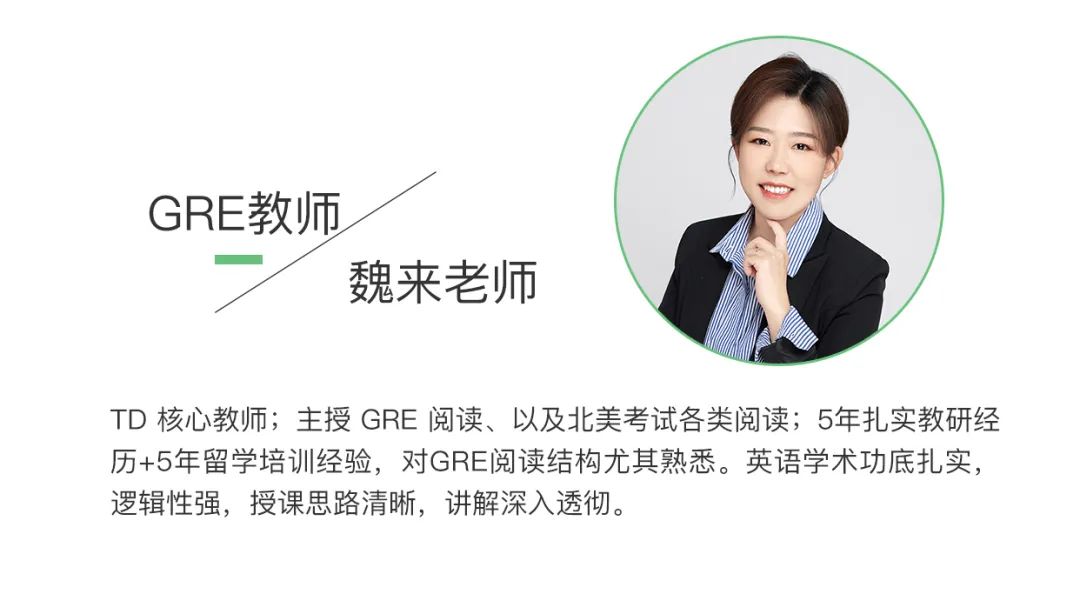
TD福利 & 领取方式
TD教研组除了为大家准备了GRE阅读真题外,还准备了GRE其他考试备考资料,清单如下,进群免费下载:

扫码下方二维码,添加马甲微信,发送暗号「 GRE干货」即可免费入群哦~
注:已经添加马甲微信的同学就不用重复添加啦~
2020申请季,备考路上TD陪你一起前行

推荐阅读
👉GRE写作Argument 为何总拿不到高分?原来中了这些坑!2022版GRE写作全题库免费下载
👉GRE阅读真题及答案及解析:Passage 67-GRE阅读真题免费下载
👉GRE数学总是拿不到满分?这三大类思维误区可能影响了你的做题思路!
- GRE派 微信号:gh_de50d3f392f5
- *侵权请邮件联系563067852@qq.com,安排删除。







